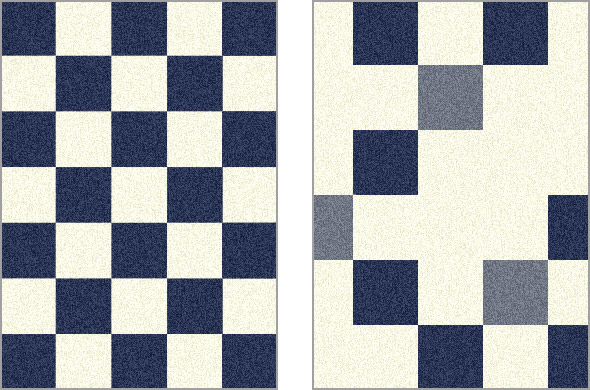|
||
 |
||

@
(C)2001 Japanese Architecture and Art Net Users System.@No reproduction or republication without written permission.
fΪΜeLXgEΚ^ECXgΘΗASΔΜRecΜ³f‘»E]ΪπΦΆά·B
|
||||||
| @ | ||||||
| ishidatamimon@ΞτΆ | ||||||
| KEY WORD :@art history / paintings | ||||||
| @ | ||||||
| Also written αKΆ. Also arare θΕ or *ichimatatsu sΌ. A checkerboard pattern named for its resemblance to paving stones ishidatami Ξτ. A type of traditional design based on Heian court decoration
*yuusoku mon'you
LEΆl. The pattern can be found on the clothing of haniwa ϋΦ figurines (mid-4c
to early 7c), and on dyed textiles from the *Shousouin ³q@. In the 9c, Heian courtiers
alternatively called a small checkerboard pattern arare, a term meaning
hail or small rice-cake cubes. The ishidatami pattern continued to
be popular, and was favored by both aristocrats and warriors. Widely used in the
middle ages on clothing, in particular, nou
costumes *noushouzoku \©, lacquer ware *urushinuri ½h, as well as architectural decoration in the Edo period.
A variety of fabric designs that run motifs over a checkerboard pattern
ground also became popular in the Edo period. |
||||||
| @ | ||||||
 |
||||||
@ |
||||||
| REFERENCES: | ||||||
| @ | ||||||
| EXTERNAL LINKS: | ||||||
| @@ | ||||||
| NOTES: | ||||||
| @ | ||||||
(C)2001 Japanese Architecture and Art Net Users System.@No reproduction or republication without written permission. fΪΜeLXgEΚ^ECXgΘΗASΔΜRecΜ³f‘»E]ΪπΦΆά·B |
||||||
| @ |